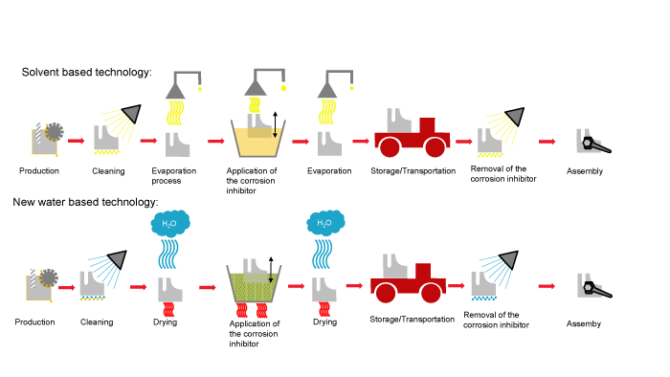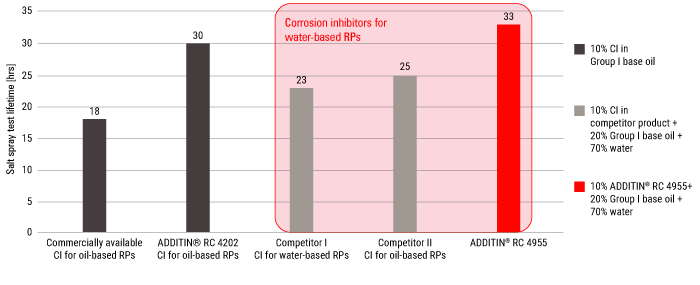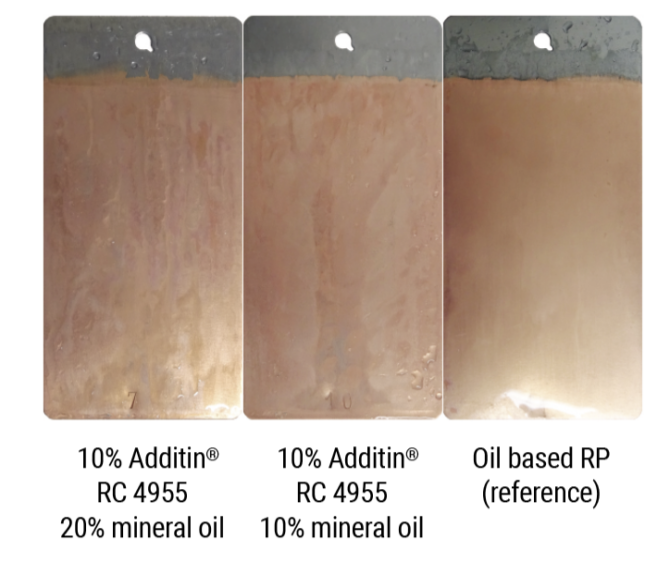
New Engine and Fuel Technology Opens Doors for Corrosion Inhibitors
Each year on April 24, World Corrosion Awareness Day shines the spotlight on the consequences and implications of rust and corrosion.
A natural phenomenon, corrosion refers to the deterioration of a metal when the surface is oxidized, often due to moisture, humidity and condensation in the environment in which it is used, stored or transported.
According to the Association for Materials Protection and Performance (AMPP), the problem accounts for an estimated $2.5 trillion of damage worldwide—or 3.4% of global gross domestic product.
However, by taking preventative measures, the AMPP suggests that proper protection and corrosion control could lower those costs by some 15% up to 35%, which is equivalent to about $375-$875 billion in savings every year.
Failing to adequately address corrosion is not only damaging to your bottom line but can also have significant health and safety implications, affect machinery, and impact production and performance.
Corrosion inhibitors are essential for protecting metal surfaces, forming a protective layer that acts as a barrier when exposed to water air or certain environmental conditions.
Engine oils, for example, tend not to use dedicated corrosion inhibitors right now because they contain metal detergent, which already offers adequate protection. Meanwhile, corrosion protection is extremely important for industrial oils and metalworking fluids to prevent exposed metals from degradation.
Corrosion inhibitors are used in myriad applications across many industries, including transportation, metalworking, water treatment, chemical manufacturing as well as the oil and gas sector. Without them, infrastructure would crumble, pipelines would rupture and machinery and equipment would fail.
Their success depends not only on their effectiveness and suitability for that specific application, but they must also factor in increasingly stringent health and regulatory requirements because of growing concerns about toxicity and potential damage to the environment.
Often used in challenging and extremely demanding conditions, corrosion inhibitors represent a comparatively small but vital portion of the lubricant additives market.
One particular area of potential growth is in the automotive sector. This is particularly true as the move toward electrification and cleaner fuel sources gathers pace. As lubricant and fuel additives, corrosion inhibitors are likely to play an increasingly important role in the transition away from the conventional internal combustion engine, suggested Philip Reeve, director of United Kingdom-based ADLU Consultancy.
“A potential growth area for corrosion inhibitors is where you get more water ingress into lubricant systems, particularly driven by alternative fuels,” Reeve said.
Fully electric transmissions and motors tend to be closed systems and are fill-for-life, thereby minimizing the risk of water ingress and corrosion. However, the continued uptick in demand for hybrid engines in the coming years means corrosion is likely to become more of an issue, and preventative measures will need to be taken, he said.
“With hybrid engines tending to run cooler and not operating for a period of time when you’re just using the battery as the power source, these hybrid engines may be more prone to corrosion,” Reeve said. “You’re going to get more fuel dilution and water contamination in the oil through combustion.”
It’s clear that engine technology will affect the treat rates of corrosion inhibitors, but what might happen when the types of fuels being burned change, too?
“And if we do eventually switch to more oxygenated fuels like ethanol or methanol, again you’re creating much more water in the system—particularly if the engine’s running cooler—and potentially facing more corrosion issues there as well,” Reeve explained.
Beyond their use in modern motor vehicles, Reeve also expects to see growing demand for corrosion inhibitors from the marine industry moving forward.
Methanol, ammonia and hydrogen are all being touted as likely alternatives to heavy fuel oil and even the low-sulfur fuels that are currently in use.
“If we do move to these engine systems, it could be pretty challenging in terms of corrosion and needing to protect the various metal surfaces,” Reeve said.
When used as a fuel, both methanol and hydrogen generate water, which itself poses an increased risk of corrosion. Meanwhile, ammonia is also corrosive toward copper as well as copper alloys.
Hydrogen is being considered as an option as a fuel for the heavy-duty diesel segment as well, Reeve said.
A switch to hydrogen as a fuel would help to lower harmful emissions while also being able to make use of modified combustion engines and existing infrastructure. Hydrogen would also be particularly suited to larger, heavier vehicles. These vehicles include trucks and buses, for which electrification may not always provide the required levels of power or performance.
“Although there is a large incentive to move toward a more hydrogen-based combustion engine, there will also be a lot of challenges as well,” Reeve cautioned. “Potentially, with these different fuel sources there could be more issues with corrosion and rust. So there will be opportunities for more use of these kinds of additives to offer protection.”
The real unknown, Reeve added, is the extent to which these cleaner fuel sources will become an integral part of the transport infrastructure as well as the implications that will have.
In this spotlight, LANXESS demonstrates how its water-based corrosion inhibitors offer enhanced protection.

LANXESS Additin® RC 4955 offers excellent rust protection in aqueous applications
Corrosion is an age-old problem that causes metals to gradually degrade or deteriorate by reacting with a corrosive component to form an oxide, hydroxide or sulfide. Examples of destructive agents are humid air, salty climate, water, active free sulfur and acids.
The result can be hugely problematic, damaging the integrity of equipment or machinery and impacting its operation. This can have an adverse effect on both performance and safety, and can be extremely expensive to remedy.
The issue has become even more important in recent decades given the significant increase in goods being transported by road and sea. Cargoes shipped by sea, in particular, have to endure a highly corrosive saline environment for weeks at a time, the weather can be poor and storage conditions tend to be humid or wet.
According to a study from the year 2016, the annual global costs of corrosion are approximately 2.5 trillion U.S. dollars. The economic damage caused by corrosion each year in industrial countries is estimated at three to four percent of GDP, according to Isabell Lange, Application Technology Manager at LANXESS’ Lubricant Additives Business.
There are two ways to protect metal from corrosion: active and passive. Whereas active protection may involve adding a chemical compound or using a sacrificial metal, passive corrosion protection often means using an organic/inorganic coating system to shield the metal from oxygen and water.
LANXESS corrosion inhibitors are only used in passive systems.
Increasingly strict regulations and requirements globally are making it necessary to develop corrosion inhibitors that are more environmentally friendly and don’t rely on volatile organic compounds (VOCs). With VOC components intensifying global warming and forming ground-level ozone, some are even classified as toxic. Rules and controls for VOCs are being enforced to help minimize damage to the environment.
LANXESS has addressed these concerns with the development of its innovative new additive package for water-based rust preventatives, Additin® RC 4955, which offers temporary corrosion protection and works with water as a solvent.
Whereas established processes for products that contain hydrocarbons require an extraction and recovery system to prevent vapors being released into the environment, LANXESS’ new technology releases only water vapor. This has the added health benefit of not exposing employees to any harmful vapors whatsoever.
Blending the finished rust preventative at a temperature of 140°F (60°C) secures its optimal quality. Additionally, warming it up to 140°F (60°C) during usage ensures a thinner, uniform film thickness and fast drying of the treated parts (Figure 1).
Figure 1. Application of rust preventatives based on organic solvent or water

The results achieved with this water-based end product are comparable to, if not better than, oil-based corrosion rust preventative and boast a service life of 30 to 33 hours in the salt spray test chamber (Figure 2) and up to 220 hours in the humidity (Kesternich) chamber. Furthermore, it makes no difference whether the aqueous rust preventative is applied by immersion or spraying.
Figure 2. Salt spray test results of different rust preventative formulations acc. to ASTM B117

Washability tests demonstrate that rust preventatives based on Additin® RC 4955 can be easily and completely washed off using a suitable aqueous alkaline cleaner. Using a cleaner according to the VDA (German automotive industry association) standard 230-201, metal sheets were placed for three minutes in a water-based cleaning solution at 140°F (60°C). They were then rinsed with deionized water for 30 seconds. To verify the cleaning effect, the sheets were afterwards dipped into a 10% solution of copper sulfate. The sheet surface that was then copper plated was completely free of any contamination (Figure 3).
Beside the absence of VOCs in Additin® RC 4955, mentioned above, it is also not flammable and lacks a flash point. As no dangerous vapors are emitted, exhaust treatment systems are no longer necessary, either.
Figure 3. Washability of Additin® RC 4955 containing RP formulations

Another benefit is a lower transport volume as well—approximately two-thirds of the end product is added at the shop floor where the rust preventative is applied—because water is generally available on-site. Moreover, there are less stringent requirements in terms of storage conditions because the rust preventative does not contain flammable solvents.
For more information about LANXESS and its Additin® RC 4955 corrosion inhibitor, visit https://lanxess.com/en/Products-and-Brands/Products/a/ADDITIN-. Any questions, contact Isabell Lange, Application Technology Manager at Isabell.Lange@lanxess.com or Technical Sales Managers Florian Kirchner (Florian.Kirchner@lanxess.com) and Wigand Braune (Wigand.Braune@lanxess.com).
Key features of the LANXESS Additin® RC 4955 water-based rust preventative package:
• VOC free, no flashpoint and less safety labeling of the finished water based end-user product.
• The first in the LANXESS portfolio that addresses the increasingly important sustainability trends and has less of an impact on human health and the environment.
• Designed to be added to mineral oil or suitable synthetic esters and then emulsified with water.
• Excellent emulsion stability.
• Forms a thin, hydrophobic soft film.
• Excellent metal wetting properties.
• With the water-based technology, no exhaust treatment is required.
• Is economically attractive thanks to less stringent requirements in terms of storage conditions and a lower storage volume.